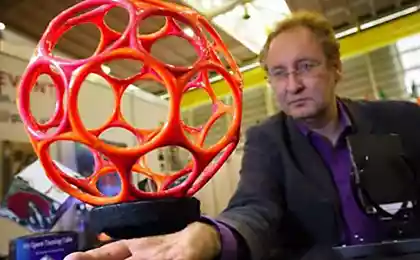999
12 Russian inventions that changed the world
Which country invented the radio? A helicopter? Russia's contribution to world progress more than it seems. We have selected a dozen ingenious technological solutions come from our country
Will be 13 photos + text source.

Electroplating
We so often meet with products that look like metal but is actually made of plastic and covered with a layer of metal that have ceased to notice them. Still there is metal products coated with different metal - e.g., nickel. And there are metal products, which are in fact a copy of the non-metallic substrate. All these wonders we owe to the genius of Russian physicist Boris Jacobi - by the way, the elder brother of the great German mathematician Carl Gustav Jacobi.
Passion Jacobi physics resulted in the creation of the world's first motor with direct shaft rotation, but one of the most important of his discoveries was the electroforming - the deposition of metal on the form, allowing you to create perfect copies of the original object. In this way they were created, such as a sculpture on St. Isaac's Cathedral naves. Electroplating can be used even at home.
Electroforming method and its derivatives find numerous applications. With it, which just did not do until now, until the cliches of state banks. Jacobi received a discovery in the Russian Demidov Prize, and in Paris - a gold medal. Possibly, also made thereby method.

Electric
In the last third of the XIX century, the world embraced uniform electric fever. Therefore, electric cars do all and sundry. This was the "golden age" of electric cars. The cities were smaller and mileage per charge to 60 kilometers was quite acceptable. One of the enthusiasts was an engineer Hippolyte Romanov, who in 1899 created several models of electric cabs.
But the main thing is not even that. Romanov invented and created in the metal electric omnibus 17 passengers, developed a scheme for the urban routes of the ancestors of modern trolleybuses and received a work permit. True, under its own commercial risk.
Find the desired amount of an inventor could not, much to the delight of competitors - owners of Conoco and numerous cabs. However, working elektroomnibus aroused great interest among inventors and others remained in the history of art to the invention, killed the municipal bureaucracy.

Pipeline transportation
What is considered the first true pipe is hard to say. You may recall offer Dmitri Mendeleev, dating back 1863, when he proposed to the Baku oil mines to deliver oil from production areas to the sea port is not in barrels, and the pipes. Mendeleev's proposal was not accepted, and two years later the first pipeline was built, Americans in Pennsylvania. As always, when something is done abroad is starting to do in Russia. Or, at least, to allocate money.
In 1877, Alexander Bari and his assistant Vladimir Shukhov perform again with the idea of pipeline transport, already relying on the American experience, and again on the authority of the Mendeleev. As a result, Shukhov in 1878 built the first oil pipeline in Russia, proved the convenience and practicality of pipeline transport. Example of Baku, who was then one of the two leaders of the world's oil, has become contagious, and "sit on the pipe" was the dream of any enterprising person. Photo: view trehtopochnogo cube. Baku 1887

Arc welding
Nikolai Benardos comes from Novorossiysk Greeks living on the Black Sea. He is the author of over one hundred inventions, but went down in history thanks to the arc welding of metals, which are patented in 1882 in Germany, France, Russia, Italy, England, the United States and other countries, called his method "elektrogefestom».
Method Benardos spread across the globe like wildfire. Instead of messing around with rivets, bolts, it was simple enough to cook pieces of metal. However, it took nearly half a century, to welding finally took the leading position among the installation methods. It seems to be a simple method - to create an electric arc between the consumable electrode in the hands of the welder and metal pieces that need to cook. But the decision gracefully. However, it did not help the inventor to age with dignity, he died in poverty in 1905 in the poorhouse.

Multiengine aircraft
Multiengine airplane "Ilya Muromets»
It is difficult to believe, but a little more than a hundred years ago it was thought that multiengined aircraft will be extremely difficult and dangerous to drive. Prove the absurdity of these statements Igor Sikorsky, who in the summer of 1913 flew the twin-engine aircraft, known as Le Grand, and then his four-engine option - "Russian Vityaz».
February 12, 1914 in Riga, at the site Russian-Baltic Shipyard in the air has risen four-engine "Ilya Muromets". On board the four-engine plane had 16 passengers - an absolute record for the time. The plane was a comfortable lounge, heating, bath with toilet and ... promenade deck. In order to demonstrate the capabilities of the aircraft in the summer of 1914 Igor Sikorsky has committed to the "Ilya Muromets" flight from St. Petersburg to Kiev and back, setting a world record. During the First World War, these planes were the first in the world of heavy bombers.

Helicopter and kvadrolet
Kvadrolet Botezatu
Igor Sikorsky, and also created the first production helicopter, he became R-4, or S-47, which the company Vought-Sikorsky began producing in 1942. It was the first and only helicopter that participated in World War II in the Pacific theater of operations, as staff transport and to evacuate the wounded.
But it is unlikely US military would give Igor Sikorsky helicopter safely experiment with the technique, if not surprising rotor helicopter George Botezatu, in 1922 began to experience a helicopter, which he ordered the US military. The first real helicopter off the ground and was able to stay in the air. Possibility of vertical flight, thus proved.
Helicopter Botezatu called "flying octopus" because of its interesting design. It was quadrocopter four screws placed at the ends of metal trusses and control system located in the center - a hair's breadth as a modern radio-controlled drones.

Color photo
Color photograph appeared in the late XIX century, but the pictures of the time characterized by a shift in a particular part of the spectrum. Russian photographer Sergey Prokudin-Gorsky was one of the best in Russia and, like many of his colleagues around the world, wanted to achieve the most natural color.
In 1902, Prokudin-Gorsky studied color photographic business in Germany, Adolf Miethe, who at that time was a world star of color photography. Returning home, Prokudin-Gorsky was the perfect chemistry of the process and in 1905 patented his own sensitizer is a substance that increases the sensitivity of photographic plates. As a result, he was able to get the negatives of exceptional quality.
Prokudin-Gorsky organized several expeditions to the territory of the Russian Empire, removing and famous people (such as Leo Tolstoy), and peasants, churches, landscapes, plants - thus creating an amazing collection of colorful Russian. Demonstrations Prokudin-Gorsky aroused great interest in the world and prompted other professionals to develop new principles of color printing.

Parachute
Gleb Kotelnikov with his invention
As you know, the idea of a parachute offered by Leonardo da Vinci, and a few centuries later, with the advent of aeronautics, began regular jumping out of balloons: the parachutes suspended beneath them in a partially open state. In 1912, the American Barry could with parachute off the plane and, more importantly, living down on the ground.
We solve the problem in his own way. For example, American Stefan Banic has made a parachute in the form of telescopic umbrella spokes that are fastened around the body of the pilot. This design worked, but still was not very convenient. But the engineer Gleb Kotelnikov decided that the whole point of the material, and made his parachute silk, wrap it in a compact pack. Kotelnikov patented his invention in France on the eve of the First World War.
But besides knapsack parachute, he came up with another interesting thing. Detection of a parachute he had revealing it while driving a car that just got up in his tracks. So Kotelnikov invented the parachute as a brake system for emergency braking aircraft.

Theremin
The history of this musical instrument makes a strange "cosmic" sounds, it began with the development alarm. It was then that a descendant of French Huguenots Leon Theremin in 1919 drew attention to the fact that a change in body position near the antenna resonant circuits affect the volume and tone of the control dynamics.
The rest was a matter of technique. And Marketing: Theremin showed his musical instrument to the head of the Soviet state, Vladimir Lenin, enthusiast of the Cultural Revolution, and then showed it to the States.
Life Lev Theremin was difficult, and he knew the ups and glory, and camps. His musical instrument are still alive. The coolest version - a Moog Etherwave. Theremin can be heard in the most advanced and quite pop performers. This is really the invention of all time.

Color TV
Vladimir Zworykin was born in a family of merchants in Murom. The boy was able to read a lot in childhood, and put all sorts of experiments - this passion for science, his father strongly encouraged. Began studying at St. Petersburg, he learned of the cathode-ray tubes and concluded that it is for the future of television electronic circuits.
Zvorykin lucky time he left Russia in 1919. For many years he worked in the early 30's patented transmitting television tube - Ike. Earlier, he designed one of the options the host tube - CRT. And then, in 1940, he broke the light beam on the blue, red and green and got color TV.
In addition, Zworykin developed a night vision device, an electron microscope and a lot of interesting things. He invented his long life, and even in retirement continued to amaze with their new solutions.

VCR
AMPEX company created in 1944, a Russian emigre Alexander concept which took three letters for the name of his initials and added EX - short for «excellent». Initially Ponyatov produced sound recording equipment, but in the early '50s focused on the development of the video.
By the time the experiments were recording TV imaging, but they require a huge amount of tape. Concept and colleagues proposed to record the signal across the belt by rotating the unit heads. November 30, 1956 aired the first pre-recorded news CBS. And in 1960, in the person of its leader and founder received the "Oscar" for outstanding contributions to the technical equipment of the film and television industry.
Fate brought Alexander Poniatowa with interesting people. He was a competitor Zworykin, working with him Ray Dolby, creator of the famous system of noise reduction, and one of the first customers and investors was the famous Bing Crosby. And again, on the order of Poniatowa about any office necessarily planted birch - in memory of the homeland.

Tetris
A long time ago, 30 years ago, the Soviet Union was a popular puzzle game "Pentamino": it was necessary to lay on the field is lined in the box different shapes composed of five squares. Produced even collections of problems, and there was a discussion of the results.
From a mathematical point of view, this was a great puzzle game for the computer test. And researcher Computing Center USSR Academy of Sciences Alexey Pajitnov wrote a program for your computer "Electronics 60". But power is not enough, and Alexei removed one die of the figures, that is done "tetramino." And then came the idea that the figures fell in the "glass". So there was Tetris.
It was the first computer game from behind the Iron Curtain, and for many the first computer game at all. And though it has a lot of new toys, Tetris continues to attract its apparent simplicity and the complexity of the real. ©
All!

Source:
Will be 13 photos + text source.

Electroplating
We so often meet with products that look like metal but is actually made of plastic and covered with a layer of metal that have ceased to notice them. Still there is metal products coated with different metal - e.g., nickel. And there are metal products, which are in fact a copy of the non-metallic substrate. All these wonders we owe to the genius of Russian physicist Boris Jacobi - by the way, the elder brother of the great German mathematician Carl Gustav Jacobi.
Passion Jacobi physics resulted in the creation of the world's first motor with direct shaft rotation, but one of the most important of his discoveries was the electroforming - the deposition of metal on the form, allowing you to create perfect copies of the original object. In this way they were created, such as a sculpture on St. Isaac's Cathedral naves. Electroplating can be used even at home.
Electroforming method and its derivatives find numerous applications. With it, which just did not do until now, until the cliches of state banks. Jacobi received a discovery in the Russian Demidov Prize, and in Paris - a gold medal. Possibly, also made thereby method.

Electric
In the last third of the XIX century, the world embraced uniform electric fever. Therefore, electric cars do all and sundry. This was the "golden age" of electric cars. The cities were smaller and mileage per charge to 60 kilometers was quite acceptable. One of the enthusiasts was an engineer Hippolyte Romanov, who in 1899 created several models of electric cabs.
But the main thing is not even that. Romanov invented and created in the metal electric omnibus 17 passengers, developed a scheme for the urban routes of the ancestors of modern trolleybuses and received a work permit. True, under its own commercial risk.
Find the desired amount of an inventor could not, much to the delight of competitors - owners of Conoco and numerous cabs. However, working elektroomnibus aroused great interest among inventors and others remained in the history of art to the invention, killed the municipal bureaucracy.

Pipeline transportation
What is considered the first true pipe is hard to say. You may recall offer Dmitri Mendeleev, dating back 1863, when he proposed to the Baku oil mines to deliver oil from production areas to the sea port is not in barrels, and the pipes. Mendeleev's proposal was not accepted, and two years later the first pipeline was built, Americans in Pennsylvania. As always, when something is done abroad is starting to do in Russia. Or, at least, to allocate money.
In 1877, Alexander Bari and his assistant Vladimir Shukhov perform again with the idea of pipeline transport, already relying on the American experience, and again on the authority of the Mendeleev. As a result, Shukhov in 1878 built the first oil pipeline in Russia, proved the convenience and practicality of pipeline transport. Example of Baku, who was then one of the two leaders of the world's oil, has become contagious, and "sit on the pipe" was the dream of any enterprising person. Photo: view trehtopochnogo cube. Baku 1887

Arc welding
Nikolai Benardos comes from Novorossiysk Greeks living on the Black Sea. He is the author of over one hundred inventions, but went down in history thanks to the arc welding of metals, which are patented in 1882 in Germany, France, Russia, Italy, England, the United States and other countries, called his method "elektrogefestom».
Method Benardos spread across the globe like wildfire. Instead of messing around with rivets, bolts, it was simple enough to cook pieces of metal. However, it took nearly half a century, to welding finally took the leading position among the installation methods. It seems to be a simple method - to create an electric arc between the consumable electrode in the hands of the welder and metal pieces that need to cook. But the decision gracefully. However, it did not help the inventor to age with dignity, he died in poverty in 1905 in the poorhouse.

Multiengine aircraft
Multiengine airplane "Ilya Muromets»
It is difficult to believe, but a little more than a hundred years ago it was thought that multiengined aircraft will be extremely difficult and dangerous to drive. Prove the absurdity of these statements Igor Sikorsky, who in the summer of 1913 flew the twin-engine aircraft, known as Le Grand, and then his four-engine option - "Russian Vityaz».
February 12, 1914 in Riga, at the site Russian-Baltic Shipyard in the air has risen four-engine "Ilya Muromets". On board the four-engine plane had 16 passengers - an absolute record for the time. The plane was a comfortable lounge, heating, bath with toilet and ... promenade deck. In order to demonstrate the capabilities of the aircraft in the summer of 1914 Igor Sikorsky has committed to the "Ilya Muromets" flight from St. Petersburg to Kiev and back, setting a world record. During the First World War, these planes were the first in the world of heavy bombers.

Helicopter and kvadrolet
Kvadrolet Botezatu
Igor Sikorsky, and also created the first production helicopter, he became R-4, or S-47, which the company Vought-Sikorsky began producing in 1942. It was the first and only helicopter that participated in World War II in the Pacific theater of operations, as staff transport and to evacuate the wounded.
But it is unlikely US military would give Igor Sikorsky helicopter safely experiment with the technique, if not surprising rotor helicopter George Botezatu, in 1922 began to experience a helicopter, which he ordered the US military. The first real helicopter off the ground and was able to stay in the air. Possibility of vertical flight, thus proved.
Helicopter Botezatu called "flying octopus" because of its interesting design. It was quadrocopter four screws placed at the ends of metal trusses and control system located in the center - a hair's breadth as a modern radio-controlled drones.

Color photo
Color photograph appeared in the late XIX century, but the pictures of the time characterized by a shift in a particular part of the spectrum. Russian photographer Sergey Prokudin-Gorsky was one of the best in Russia and, like many of his colleagues around the world, wanted to achieve the most natural color.
In 1902, Prokudin-Gorsky studied color photographic business in Germany, Adolf Miethe, who at that time was a world star of color photography. Returning home, Prokudin-Gorsky was the perfect chemistry of the process and in 1905 patented his own sensitizer is a substance that increases the sensitivity of photographic plates. As a result, he was able to get the negatives of exceptional quality.
Prokudin-Gorsky organized several expeditions to the territory of the Russian Empire, removing and famous people (such as Leo Tolstoy), and peasants, churches, landscapes, plants - thus creating an amazing collection of colorful Russian. Demonstrations Prokudin-Gorsky aroused great interest in the world and prompted other professionals to develop new principles of color printing.

Parachute
Gleb Kotelnikov with his invention
As you know, the idea of a parachute offered by Leonardo da Vinci, and a few centuries later, with the advent of aeronautics, began regular jumping out of balloons: the parachutes suspended beneath them in a partially open state. In 1912, the American Barry could with parachute off the plane and, more importantly, living down on the ground.
We solve the problem in his own way. For example, American Stefan Banic has made a parachute in the form of telescopic umbrella spokes that are fastened around the body of the pilot. This design worked, but still was not very convenient. But the engineer Gleb Kotelnikov decided that the whole point of the material, and made his parachute silk, wrap it in a compact pack. Kotelnikov patented his invention in France on the eve of the First World War.
But besides knapsack parachute, he came up with another interesting thing. Detection of a parachute he had revealing it while driving a car that just got up in his tracks. So Kotelnikov invented the parachute as a brake system for emergency braking aircraft.

Theremin
The history of this musical instrument makes a strange "cosmic" sounds, it began with the development alarm. It was then that a descendant of French Huguenots Leon Theremin in 1919 drew attention to the fact that a change in body position near the antenna resonant circuits affect the volume and tone of the control dynamics.
The rest was a matter of technique. And Marketing: Theremin showed his musical instrument to the head of the Soviet state, Vladimir Lenin, enthusiast of the Cultural Revolution, and then showed it to the States.
Life Lev Theremin was difficult, and he knew the ups and glory, and camps. His musical instrument are still alive. The coolest version - a Moog Etherwave. Theremin can be heard in the most advanced and quite pop performers. This is really the invention of all time.

Color TV
Vladimir Zworykin was born in a family of merchants in Murom. The boy was able to read a lot in childhood, and put all sorts of experiments - this passion for science, his father strongly encouraged. Began studying at St. Petersburg, he learned of the cathode-ray tubes and concluded that it is for the future of television electronic circuits.
Zvorykin lucky time he left Russia in 1919. For many years he worked in the early 30's patented transmitting television tube - Ike. Earlier, he designed one of the options the host tube - CRT. And then, in 1940, he broke the light beam on the blue, red and green and got color TV.
In addition, Zworykin developed a night vision device, an electron microscope and a lot of interesting things. He invented his long life, and even in retirement continued to amaze with their new solutions.

VCR
AMPEX company created in 1944, a Russian emigre Alexander concept which took three letters for the name of his initials and added EX - short for «excellent». Initially Ponyatov produced sound recording equipment, but in the early '50s focused on the development of the video.
By the time the experiments were recording TV imaging, but they require a huge amount of tape. Concept and colleagues proposed to record the signal across the belt by rotating the unit heads. November 30, 1956 aired the first pre-recorded news CBS. And in 1960, in the person of its leader and founder received the "Oscar" for outstanding contributions to the technical equipment of the film and television industry.
Fate brought Alexander Poniatowa with interesting people. He was a competitor Zworykin, working with him Ray Dolby, creator of the famous system of noise reduction, and one of the first customers and investors was the famous Bing Crosby. And again, on the order of Poniatowa about any office necessarily planted birch - in memory of the homeland.

Tetris
A long time ago, 30 years ago, the Soviet Union was a popular puzzle game "Pentamino": it was necessary to lay on the field is lined in the box different shapes composed of five squares. Produced even collections of problems, and there was a discussion of the results.
From a mathematical point of view, this was a great puzzle game for the computer test. And researcher Computing Center USSR Academy of Sciences Alexey Pajitnov wrote a program for your computer "Electronics 60". But power is not enough, and Alexei removed one die of the figures, that is done "tetramino." And then came the idea that the figures fell in the "glass". So there was Tetris.
It was the first computer game from behind the Iron Curtain, and for many the first computer game at all. And though it has a lot of new toys, Tetris continues to attract its apparent simplicity and the complexity of the real. ©
All!

Source:























